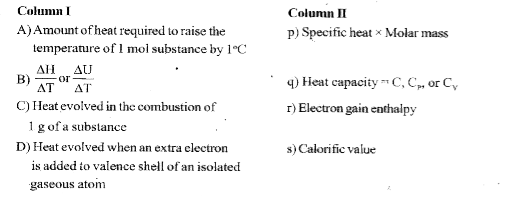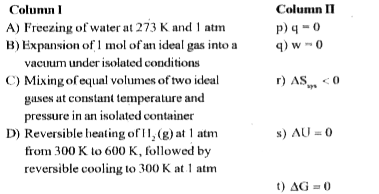LEVEL-III from BRILLIANT PUBLICATION CHEMICAL THERMODYNAMICS for Class 11
| Class 11 | CHEMISTRY |
| Chapter | CHEMICAL THERMODYNAMICS |
| BRILLIANT PUBLICATION | LEVEL-III |
| Medium | English |
| Academic Year | 2023-2024 |
Question 5
A sample containing 2.000 mol of helium gas originally at 298.15 K and 1.000 bar is cooled to its norm boiling temperature of 4K, condensed to a liquid and then cooled further to 2 K, where it undergoes anoth phase transition to a second liquid form, called liquid helium II. Abeam of laser light suddenly vapourizes th liquid phase, and the helium is brought to a temperature of 298.15 Ķ and a pressure of 0.500 bar. The entropy change for the above process is:View SolutionQuestion 7
A piston is cleverly designed so that it extracts the maximum amount of work out of a chemical reaction, by matching Pestera to the Pistema at all times. This 8cm diameter piston initially holds back 1 mol of gas occupying 1 L, and comes to rest after being pushed out a further 2 L at 25∘C. After exactly half of the work has been done, the piston has travelled out a total of .View SolutionQuestion 8
A reaction from unknown reactants (R):R→P is spontaneous at 37∘C and goes to completion. If the molar entropy of the products (P) is measured to be 460 J/mol K, and 71.3 kJ of heat was given off in the process to the surroundings when I mol reacted, then the molar entropy of the reactants has to beView SolutionQuestion 9
3 moles of an ideal gas (Cv,m =3/2 R) are initially in an insulated piston-fitted cylinder at a constant pressure. The volume of the gas is initially 40 L. The cylinder is then placed in contact with a constant temperature bath at 500 K. Bringing the bath in contact with the cylinder causes 6.236 kJ of heat to transfer into the cylinder and causes the gas to expand. Find ΔSTOTAL for this process.
 View Solution
View SolutionQuestion 18
An ideal gas in a thermally insulated vessel at internal pressure =p1, volume=V1, and absolute temp=T1, expands irreversibly against zero external pressure, as shown in the below diagram. The final internal pressure volume and absolute temperature of the gas are p2,V2,andT2, respectively. For this expansion,
 View Solution
View SolutionQuestion 28
The polymerisation of propene to linear polypropene is represented by the reaction
n⎛⎜ ⎜⎝CH3∣CH=CH2⎞⎟ ⎟⎠→⎛⎜ ⎜⎝CH3∣CH−CH2−⎞⎟ ⎟⎠n
where n has large integral value, the average enthalpies of bond dissociation for(C=C) and(C-C) at 298K are +590 and +331kJmol−1, respectively. The enthalpy of polymerisation is −360kJmol−1. Find the value of n.View SolutionQuestion 44
For an ideal gas, an illustration of three different paths A, (B +C) and (D+E) from an initial state P1,V1,T1 to a final state P2,V2,T1 is shown in the given

Path A represents a reversible isothermal expansion from P1,V1, to P2,V2 Path (B +C) represents a reversible adiabatic expansion (B) from P1,V1,T1 to P3,V2,T2 followed by reversible heating the gas at constant volume (C) from P3,V2,T2 to P2,V2,T1. Path (D+E) represents a reversible expansion at constant pressure P1 from P1,V1,T1 to P1,V2,T3 followed by a reversible cooling at constant volume V2(E) frm V1,V2T3 toP2,V2,T1.
What is qrav, for path (A) ? View SolutionQuestion 45
For an ideal gas, an illustration of three different paths A, (B +C) and (D+E) from an initial state P1,V1,T1 to a final state P2,V2,T1 is shown in the given

Path A represents a reversible isothermal expansion from P1,V1, to P2,V2 Path (B +C) represents a reversible adiabatic expansion (B) from P1,V1,T1 to P3,V2,T2 followed by reversible heating the gas at constant volume (C) from P3,V2,T2 to P2,V2,T1. Path (D+E) represents a reversible expansion at constant pressure P1 from P1,V1,T1 to P1,V2,T3 followed by a reversible cooling at constant volume V2(E) frm V1,V2T3 to P2,V2,T1.
What is ΔS for path A ? View SolutionQuestion 46
For an ideal gas, an illustration of three different paths A, (B +C) and (D+E) from an initial state P1,V1,T1 to a final state P2,V2,T1 is shown in the given

Path A represents a reversible isothermal expansion from P1,V1, to P2,V2 Path (B +C) represents a reversible adiabatic expansion (B) from P1,V1,T1 to P3,V2,T2 followed by reversible heating the gas at constant volume (C) from P3,V2,T2 to P2,V2,T1. Path (D+E) represents a reversible expansion at constant pressure P1 from P1,V1,T1 to P1,V2,T3 followed by a reversible cooling at constant volume V2(E) frm V1,V2T3 toP2,V2,T1.
What is ΔS for path A ?View SolutionQuestion 47
Free energy, G=- TS, is a state funtion that indicates whether a reaction is spontaneous or non-spontaneous if you think of TS as the part of the system's energy that is discordered already, then (H-TS) is the part of system's energy that is still orderd and therefore free to cause spontaneous change by becoming disorder Also, ΔG=ΔH−TΔS
Form the second law of thermodyamics, a reaction is spontaneous if ΔtotalS is + ve, nonspontaneous if ΔtotalS is negative and at equilibrium if ΔlotS is zero. Since, −TΔS=ΔC and since ΔGandΔS have oposite single we can restate the themodynmaic creation for the spontaneity of a reaction oout at constant temperature and pressure.
If ΔG<0, the reaction is spontaneous. IfΔG>0, the reaction is non-spontaneous.
If ΔG=0, the reaction is at equilibrium.
A particular reaction has a negative value for the free enregy charge. Then at ordinary temmperature View Solution








